The book defined the red ocean as the commodity goods market. The blue ocean boils down to a hybrid ocean consisting of elements from red ocean goods and services targeted to non-buyers of the firms previous red ocean market. The white ocean wasn't really described in the book, but came up in the twitter discussion as a brand new market. The twitter discussion defined a white ocean as an ocean created by technological innovation. The book was big on how technological innovation could not persist these days, so it provided no real business proposition. This to set the stage for the need for value innovation.
The business community typically sees disruptive innovation as being very risky. But, that risk originates in the red ocean tactics that are typically used, and which really don't suit a disruptive innovation.
A blue ocean strategy would be an alternative to value-basing, mass customization, relationship marketing, demand-side services, and launching a new technology into a battle for market leadership of a new category. The whole blue ocean discussion centers on the creation of a new category without disruptive technology.
Since I think in terms of disruptive technology, I put everything into the context provided by Moore's technology adoption lifecycle. It contextualizes the category from birth to death. Moore's late market turns out to be the red ocean.
This figure shows Moore's technology adoption lifecycle as being the small normal curve to the left. The larger normal curve represents the category after it has been acquired by a large blue chip company.
The small curve would represent the Internet back in the dot boom. The larger curve is the Internet after the telcoms bought up the once disruptive Internet companies. In one particular report this larger market was ten times larger than the initial market.
In the diagram, I annotated the red oceans that the category or market is characterized as. The blue arrows show growth anticipated in each category. One a category enters the late market, growth is at an end. The contraction in the market is demonstrated by the brown arrow in the larger blue chip market. This lack of growth motivates the construction of a blue ocean strategy.
Moore talked about growth ending on the entry to the late market. Price-based competition begins earlier. As shown in the next figure.
 It is price-based competition and the proliferation of fast followers that drive growth negative. On the figure the gray area on the left represents the tornado. The tornado is where the fight for market leadership is fought. The market leader emerges from the tornado with an advantage over the rest of the field. The yellow area depicts where price-based competition and fast following begins. Again, the late market is depicted as a red ocean.
It is price-based competition and the proliferation of fast followers that drive growth negative. On the figure the gray area on the left represents the tornado. The tornado is where the fight for market leadership is fought. The market leader emerges from the tornado with an advantage over the rest of the field. The yellow area depicts where price-based competition and fast following begins. Again, the late market is depicted as a red ocean. The blue arrow depicts the interval where the most rapid growth occurs. This is also the best place to IPO. If your IPO is delayed into the red ocean region, you will find that the premium paid on your IPO falls to zero. There is no upside in the red ocean. The expectation is that you will make lower returns in the red ocean.
The far left portion of the disruptor's normal curve (white area under the curve) shows where any white ocean or new market or category is created though disruptive technology.
So you find yourself in the red ocean, and it's time to construct a blue ocean.
 First, you find an unserved population. Then, you take capabilities in your current business, extend them (black), throw some away (red), and add capabilities (brown) from other red ocean categories together to form a new hybrid (blue) category that serves that unserved population.
First, you find an unserved population. Then, you take capabilities in your current business, extend them (black), throw some away (red), and add capabilities (brown) from other red ocean categories together to form a new hybrid (blue) category that serves that unserved population. A disruptive technology would likewise seek and serve an unserverd population, unserved by the current categories, or over served customers in an existing category(Christensen). This sets Moore's technology adoption lifecycle as a competitor for blue ocean strategy formation.
The red ocean became red as differentiation was wrung out by competition and the convergence of competitors and their co-evolving markets. Competitors eventually emerge in a blue ocean and gradually turn it red, as depicted by the purple edge to the right of the blue ocean.
The book talks about how the blue ocean can be extended through IP protections and hard to copy capabilities.
The book establishes three criteria for blue ocean formation. More on this in a later post.
What do you think? Leave a comment. Thanks!


No comments:
Post a Comment